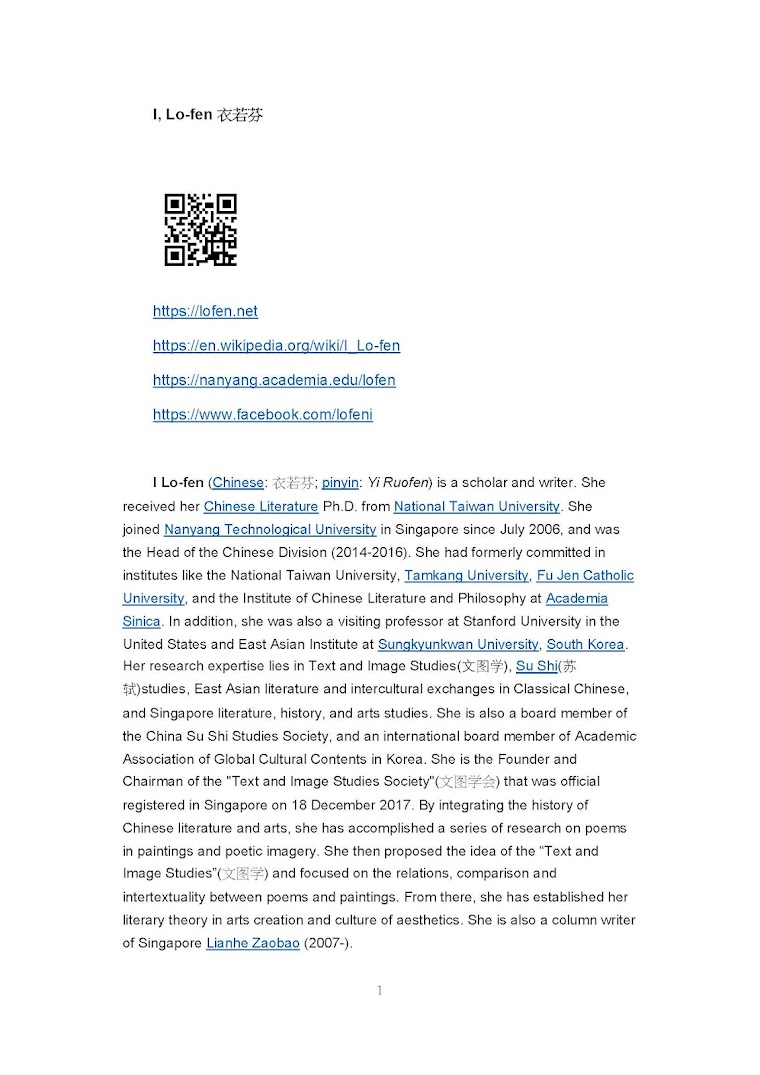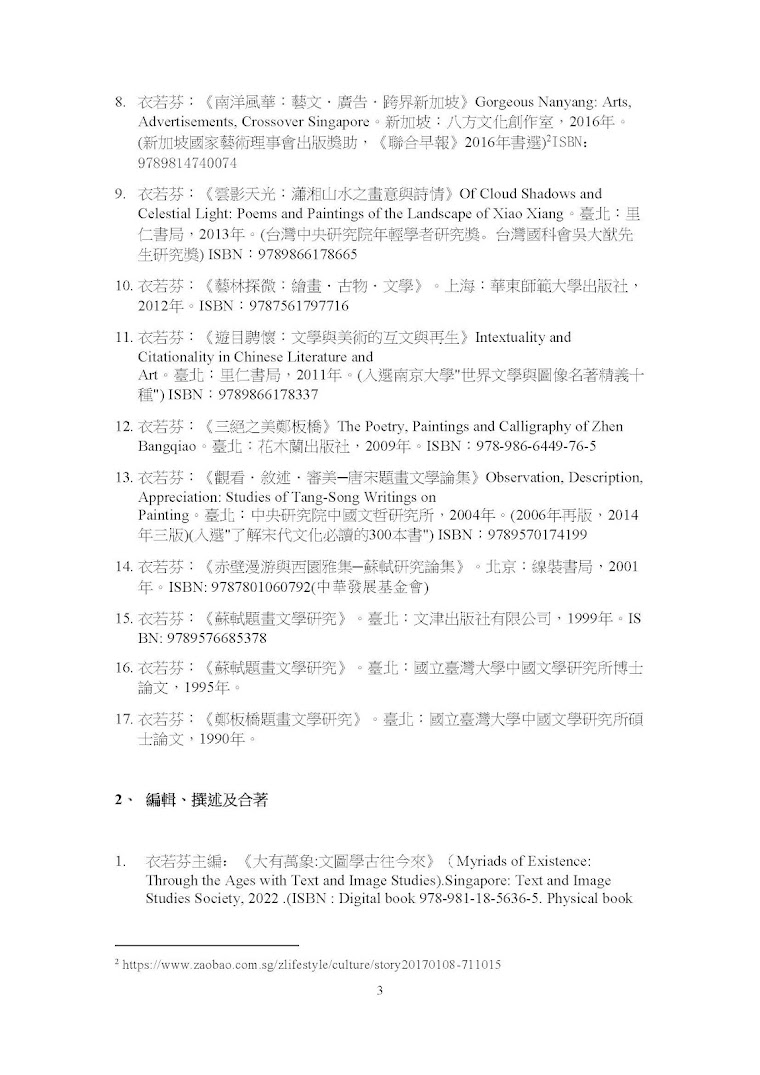 |
| 柯玉芝女士的峇迪旗袍。(衣若芬拍摄及后制) |
在新加坡土生文化馆(Peranakan Museum)看到建国总理李光耀先生的夫人柯玉芝 (Kwa Geok Choo,1920-2010)女士穿过的峇迪旗袍。想起多年前也在这间博物馆看过柯玉芝女士担任大律师时戴过的假发。
Peranakan过去经常被翻译成“土生华人”、“海峡华人”,指华人与马来族通婚的后代,男性称为峇峇(Baba),女性称为娘惹(Nyonya)。看了展示说明,知道Peranakan不只有华人。"Peranakan" 是马来语,始于15世纪,字根anak是孩子的意思,形容出生于某地但有其他血统和文化的人,比如还有爪哇Peranakan、阿拉伯Peranakan等等。
这件柯玉芝女士的峇迪旗袍挺眼熟,查了她的历史图像,得知她在晚年几次重要场合穿过,像是2004年的英国商会(British Chamber of Commerce)年会,是她2003年中风以后恢复健康第一次出席的公开活动。2010年她去世的新闻,几帧照片都可以见到她穿这件旗袍的留影。新加坡妇女组织理事会(Singapore Council of Women’s Organisations)网站上,她的照片也是穿着这件旗袍。
似乎,这件旗袍对于人们认识她,记忆她,怀念她,有着不可磨灭的意义。
我们对于柯玉芝的基本印象,就是:李光耀一生所爱,背后的坚强支柱,低调内敛的第一夫人。媒体报道她天才早慧,用功读书,曾经考试成绩超越李光耀。在培养新加坡社会精英的男校莱佛士书院(Raffles Institution),她由于表现优异,破格入学,成为唯一的女学生。后来她荣获英国女王奖学金,在剑桥大学主攻法律,成为第一位以一等荣誉学位毕业的东南亚女性,新加坡最早的女律师之一。
人们津津乐道的还有:她比李光耀大两岁,他们在剑桥大学读书期间自行决定结婚,学成归国以后才补办婚礼。柯玉芝也许说不上叛逆,但是绝对有思想主见和独立精神。她的高等学识和专业素养,使得她在新加坡独立建国期间贡献心力,尤其是和马来西亚签署新加坡用水的协议,遗泽后人,功不可没。她擅长处理房地产法律问题,为了规避公私利益冲突,她不在文件上签署自己的名字。
这样兼顾身为三个子女的母亲、国家政要的贤内助、以及个人的事业,很值得当代的女性知识分子学习。然而,她总是面带微笑跟在丈夫身旁,少言寡语。她偶尔接受访谈时说道:即使你没有做什么坏事,别人也可能说你的坏话。
严守分寸,理性沉稳。柯玉芝和新加坡其他政要夫人一样,经常在典礼仪式中穿旗袍。短发、眼镜、平跟鞋,她恰到好处展现自己的气场。从她的历年照片和国家博物馆的收藏,我注意到她的旗袍隐含着华人身份意识的变化。
旗袍在新加坡一般称为长衫。同样是立領、開右襟、下擺開衩的連身衣裙,有别于上海西式立体剪裁,长衫外形平实简约,1930年代开始流行于新加坡(参看我2021年6月19日在《联合早报》的文章)。早年,柯玉芝穿的旗袍大多是素色,有的缀饰重复的花草或几何线条纹样。大约1990年代起,她的旗袍融入了南洋的元素,那就是蜡染(峇迪,batik)艺术。
峇迪发展于17世纪的东南亚,带有鲜明的地域风情。用铜壶笔盛溶蜡液绘制图样,染布时,线条所经之处可以防止染色,达到凸显图样的效果。这件褐色峇迪旗袍遍布风铃草花,孔雀(一说凤凰)双双展翅,莲花盛开,枝蔓卷曲,旺盛的热带生命活力。
无袖峇迪旗袍搭配圆领西装外套,好一个中西加上南洋的三合一设计!减轻了纯华人性质,符合柯玉芝本人的海峡华人出身,以及有别于中国的新加坡主张。沿用罗兰·巴特(Roland Barthes)的服装符号学意义,我想,这件峇迪旗袍,是柯玉芝留给后人的政治语言。
2024年3月30日,新加坡《联合早报》“上善若水”专栏
At the Peranakan Museum in
Singapore, I saw the batik cheongsam worn by Mrs. Kwa Geok Choo (1920-2010),
the wife of Singapore's founding Prime Minister, Lee Kuan Yew. It reminded me
of the time, years ago, when I also saw the wig she wore as a barrister at this
museum.
"Peranakan" was often
translated as "Straits-born Chinese," referring to the descendants of
Chinese and Malay intermarriages. The males are called Baba, and the females
Nyonya. The exhibition explained that "Peranakan" is not limited to
Chinese; it's a Malay term that originated in the 15th century. The root
"anak" means child, describing people born in a place but with
different ancestry and culture, such as Javanese Peranakan and Arab Peranakan.
This batik cheongsam of Mrs. Kwa
Geok Choo looked familiar. Researching her historical images, I learned that
she wore it on several important occasions in her later years, such as the 2004
British Chamber of Commerce annual meeting, which was her first public
appearance after recovering from a stroke in 2003. In the news of her passing
in 2010, she was also seen wearing this cheongsam in several photos. Her
picture on the Singapore Council of Women’s Organisations website also features
her in this cheongsam.
It seems that this cheongsam has
an indelible significance in recognizing, remembering, and mourning her.
Our basic impression of Kwa Geok
Choo is that of Lee Kuan Yew's lifelong love, the strong support behind him,
and the low-profile first lady. Media reports described her as a precocious
genius who studied hard and outperformed Lee Kuan Yew in exams. At Raffles
Institution, a boys' school for nurturing Singapore's social elites, she was
admitted as the only female student due to her exceptional performance. Later,
she won the Queen's Scholarship to study law at Cambridge University, becoming
the first Southeast Asian woman to graduate with first-class honors and one of
Singapore's earliest female lawyers.
People also talk about how she was
two years older than Lee Kuan Yew, and they decided to get married on their own
while studying at Cambridge University, only holding a wedding ceremony after
returning home. Kwa Geok Choo might not be rebellious, but she definitely had
her own opinions and independence. Her higher education and professional
competence allowed her to contribute to Singapore's independence, especially in
signing the agreement for Singapore's water use with Malaysia, leaving a legacy
for future generations. She specialized in real estate law and avoided
conflicts of interest by not signing her name on documents.
Balancing her roles as a mother of
three children, a supportive partner to a national leader, and a professional
in her own right is something contemporary female intellectuals can learn from.
Yet, she always smiled and stayed quietly by her husband's side. In rare
interviews, she said, "Even if you haven't done anything wrong, people
might still speak ill of you."
Measured, rational, and composed.
Like other political wives in Singapore, Kwa Geok Choo often wore cheongsams at
ceremonial events. With short hair, glasses, and flat shoes, she perfectly
showcased her presence. From her historical photos and the National Museum's
collection, I noticed that her cheongsams reflected the changing identity
consciousness of the Chinese.
In Singapore, the cheongsam is
generally called a "long dress." Similar to the Shanghai-style with a
stand-up collar, right opening, and slits, the long dress is plain and simple,
becoming popular in Singapore since the 1930s (see my article in Lianhe Zaobao
on June 19, 2021). In her early years, Kwa Geok Choo's cheongsams were mostly
solid-colored, some adorned with repeated floral or geometric patterns. From
around the 1990s, her cheongsams incorporated elements of Nanyang, namely batik
art.
Batik, developed in 17th-century
Southeast Asia, has distinct regional characteristics. Drawing patterns with
molten wax in a copper pen prevents the lines from being dyed, highlighting the
design. This brown batik cheongsam is covered with wind chimes, peacocks (or
phoenixes) spreading their wings, blooming lotuses, and curling vines,
showcasing the vibrant tropical life.
The sleeveless batik cheongsam
paired with a round-necked suit jacket is a perfect blend of Chinese, Western,
and Nanyang styles! It reduces the pure Chinese nature, fitting Kwa Geok Choo's
Straits Chinese background and Singapore's distinct stance from China. Using
Roland Barthes' semiotics of fashion, I believe this batik cheongsam is the
political language Kwa Geok Choo left for posterity.
March 30, 2024, Lianhe Zaobao
"Shang Shan Ruo Shui" (The highest goodness is like water)Column, Singapore.












